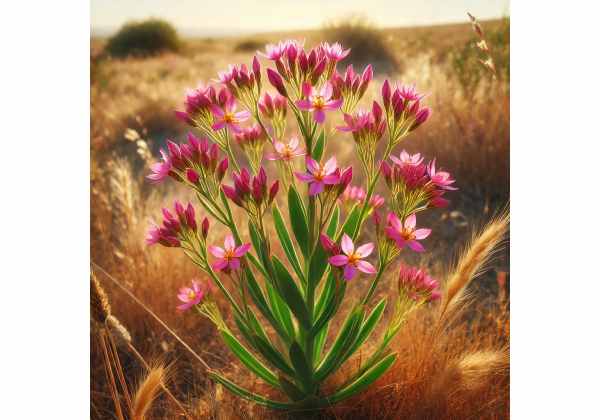
Lesser Centaury is a time-honored herb celebrated for its potent therapeutic qualities and diverse applications in traditional and modern herbal medicine. With a rich history in European folk remedies, this herb is renowned for supporting liver detoxification, reducing inflammation, and promoting digestive health. Its bioactive compounds—including flavonoids, phenolic acids, and various terpenoids—provide antioxidant, antimicrobial, and anti-inflammatory effects. Lesser Centaury is also valued for its ability to soothe skin irritations and support overall immune function. Today, it is incorporated into teas, tinctures, and topical formulations, offering a natural, holistic approach to enhancing well-being and addressing a wide range of health concerns.
Table of Contents
- Botanical Overview and Identification
- Phytochemical Profile and Active Compounds
- Health Benefits and Core Qualities
- Practical Applications and Safety Guidelines
- Scientific Research and Key Findings
- Frequently Asked Questions
Botanical Overview and Identification
Lesser Centaury (Centaurium erythraea var. minor) is a small, herbaceous perennial native to Europe, thriving in meadows, roadside verges, and open woodland edges. Belonging to the Gentianaceae family, it is characterized by its delicate, opposite leaves, slender stems, and striking, small pink to red flowers that bloom in late spring through summer. The plant typically reaches a height of 15–30 centimeters, forming low clumps that provide a subtle yet attractive ground cover in its natural habitat.
Taxonomy and Morphological Features
Lesser Centaury is taxonomically classified within the genus Centaurium. The species is noted for its slender, lanceolate leaves with finely toothed margins and a glaucous appearance. Its small, tubular flowers are arranged in loose clusters at the top of the stems. The vibrant color of the blooms, combined with the herb’s overall airy, open growth habit, makes it easily recognizable. Variations within the species are influenced by environmental factors, leading to subtle differences in leaf size, flower intensity, and overall plant vigor.
Growth Conditions and Natural Habitat
This herb favors well-drained, sandy or loamy soils and can tolerate both full sun and partial shade. It is commonly found in disturbed habitats such as field margins, roadsides, and grasslands, where it competes successfully with other wild flora. Adapted to temperate climates, Lesser Centaury thrives in regions with moderate rainfall and cool summers. Its ability to grow in nutrient-poor soils makes it an excellent candidate for natural landscaping and ecological restoration projects. In its native environment, Lesser Centaury contributes to the biodiversity of meadows and open woodland ecosystems, often serving as a food source for early-season pollinators.
Ecological and Cultural Importance
Historically, Lesser Centaury has held a special place in traditional herbal medicine. Folk healers have long employed the herb for its reputed ability to cleanse the blood, support liver function, and relieve digestive disturbances. In addition to its medicinal uses, its charming flowers have made it a symbol of early spring and renewal in various European cultures. Ecologically, the herb’s blossoms attract bees, butterflies, and other beneficial insects, aiding in pollination and maintaining the balance of local ecosystems. Its role as both a medicinal and ornamental plant has cemented its status as a valuable resource in both traditional and modern contexts.
Phytochemical Profile and Active Compounds
The therapeutic potential of Lesser Centaury is underpinned by its complex phytochemical composition. Modern studies have identified a range of bioactive compounds that work synergistically to produce its beneficial effects. Below is an in-depth exploration of the primary compounds found in this herb:
- Flavonoids
Flavonoids such as quercetin, kaempferol, and apigenin are abundant in Lesser Centaury. These compounds are known for their robust antioxidant activity, which helps neutralize free radicals and reduce oxidative stress. Their anti-inflammatory and immunomodulatory properties also contribute significantly to the herb’s overall health benefits. - Phenolic Acids
Phenolic acids, including chlorogenic acid and caffeic acid, are key constituents in Lesser Centaury. They play a crucial role in protecting cells from oxidative damage, modulating inflammatory responses, and supporting cardiovascular health. These acids contribute to the herb’s bitter taste and have been linked to improved metabolic function. - Terpenoids
Terpenoids present in Lesser Centaury, though found in smaller quantities, add to its aromatic profile and therapeutic potential. These compounds, which may include monoterpenes and sesquiterpenes, exhibit antimicrobial, anti-inflammatory, and calming properties that enhance the herb’s medicinal value. - Glycosides
Glycosides, including certain iridoid glycosides, are part of the plant’s chemical defense system. These compounds have been associated with a variety of pharmacological activities, including anti-inflammatory and hepatoprotective effects, making them valuable in traditional detoxification remedies. - Saponins
Saponins contribute to the herb’s ability to stimulate the immune system and lower cholesterol levels. They possess antimicrobial properties and help improve the overall bioavailability of other beneficial compounds present in Lesser Centaury. - Tannins
Tannins, which impart astringent properties, are responsible for the herb’s traditional use in wound healing and skin care. They help tighten tissues, reduce inflammation, and inhibit the growth of certain bacteria, making them useful in both internal and external applications. - Essential Oils
Although present in trace amounts, the essential oils of Lesser Centaury comprise a blend of volatile compounds that contribute to its distinctive aroma. These oils support antimicrobial activity and may enhance the herb’s calming effects when used in aromatherapy.
The synergistic interaction of these compounds not only defines the sensory and flavor profile of Lesser Centaury but also provides a multifaceted foundation for its diverse therapeutic properties. Ongoing research continues to explore the complex interplay among these bioactive constituents, further elucidating their roles in supporting human health and well-being.
Health Benefits and Core Qualities
Lesser Centaury has been traditionally esteemed for its wide-ranging health benefits. Modern research supports its role in detoxification, anti-inflammation, and overall wellness. The herb’s bioactive compounds confer multiple therapeutic effects that benefit various bodily systems.
Detoxification and Liver Support
- Blood Purification:
Lesser Centaury is renowned for its detoxifying properties. Traditionally used to “cleanse the blood,” its bioactive compounds facilitate the removal of toxins and support liver function. This detoxification process is vital for maintaining optimal health and preventing chronic diseases. - Hepatoprotective Effects:
The antioxidants and flavonoids in Lesser Centaury help protect liver cells from oxidative stress and damage. This protective action supports liver regeneration and overall metabolic health, reducing the risk of liver-related disorders.
Anti-inflammatory and Analgesic Effects
- Natural Pain Relief:
The anti-inflammatory properties of Lesser Centaury, driven by its flavonoids and phenolic acids, help reduce pain associated with inflammatory conditions such as arthritis and muscle aches. This makes it a valuable natural alternative to conventional pain relievers. - Inflammation Reduction:
By inhibiting the release of pro-inflammatory cytokines, the herb helps reduce chronic inflammation. This effect is beneficial in managing conditions ranging from joint inflammation to gastrointestinal disorders.
Digestive and Metabolic Benefits
- Digestive Aid:
Lesser Centaury has been used for centuries to promote healthy digestion. Its bitter compounds stimulate digestive enzymes and bile production, improving nutrient absorption and alleviating symptoms of indigestion and bloating. - Metabolic Regulation:
The herb’s ability to support liver function and enhance digestion also contributes to better metabolic regulation. This can aid in maintaining balanced blood sugar levels and supporting weight management.
Immune System Enhancement
- Immune Modulation:
The polysaccharides and flavonoids in Lesser Centaury help stimulate the immune system, promoting a stronger defense against infections. Regular consumption of its extracts can lead to a more robust immune response and overall improved health. - Antimicrobial Action:
Lesser Centaury’s antimicrobial properties help inhibit the growth of harmful bacteria and fungi, reducing the risk of infections and supporting overall immune function.
Skin and Wound Healing
- Skin Rejuvenation:
Topically, Lesser Centaury is used to treat skin conditions such as eczema, acne, and minor wounds. Its tannins and flavonoids contribute to its astringent and healing properties, promoting tissue regeneration and a clearer complexion. - Detoxification for Skin:
By promoting blood purification and detoxification, the herb helps eliminate impurities from the skin, leading to improved tone and texture. This detoxifying effect is essential for maintaining youthful, radiant skin.
Cardiovascular and Respiratory Health
- Circulatory Support:
The anti-inflammatory and antioxidant compounds in Lesser Centaury support healthy blood circulation. By reducing oxidative stress, the herb helps maintain arterial health and can contribute to lowering blood pressure. - Respiratory Benefits:
Traditionally used to treat respiratory ailments, Lesser Centaury can help alleviate symptoms of colds, bronchitis, and sinusitis. Its antimicrobial properties assist in clearing the respiratory tract, promoting easier breathing.
Cognitive and Emotional Well-Being
- Mental Clarity and Focus:
Lesser Centaury is believed to support cognitive function by enhancing cerebral blood flow and reducing inflammation. These effects can lead to improved concentration, memory, and overall mental clarity. - Stress Reduction:
The calming properties of its bioactive compounds also contribute to stress relief. Regular use may help lower anxiety levels and promote a balanced mood, supporting overall emotional health.
Collectively, the health benefits of Lesser Centaury span detoxification, anti-inflammation, digestive support, immune enhancement, skin regeneration, and cardiovascular protection. Its comprehensive therapeutic profile makes it an invaluable herb in both traditional herbal medicine and modern integrative health practices.
Practical Applications and Safety Precautions
Lesser Centaury is versatile in its applications, and its uses extend across culinary, medicinal, and cosmetic domains. The following guidelines provide practical ways to incorporate this herb into your daily routine while ensuring safe usage.
Culinary Applications
- Herbal Teas and Infusions:
One of the most popular uses of Lesser Centaury is as an herbal tea. Steep 1–2 teaspoons of dried centaury in boiling water for 10–15 minutes. The resulting infusion has a slightly bitter, earthy flavor and is traditionally consumed to support liver detoxification and digestion. - Culinary Enhancer:
Though not widely used as a culinary herb, finely chopped Lesser Centaury can be added in small quantities to salads, soups, or stews to impart its subtle, bittersweet flavor. Its use in cooking is generally complementary, adding a nuanced herbal note without overpowering other ingredients. - Extracts and Tinctures:
Concentrated extracts of Lesser Centaury are available for culinary and medicinal use. These can be added to beverages or used as flavor enhancers in sauces and dressings, providing a natural boost of antioxidants and digestive benefits.
Medicinal and Therapeutic Uses
- Internal Remedies:
Lesser Centaury is traditionally prepared as a tincture, decoction, or powdered supplement to support liver health, aid digestion, and reduce inflammation. When taken according to established dosage guidelines, these preparations can help detoxify the blood and alleviate various digestive and inflammatory conditions. Always consult a qualified herbalist or healthcare provider before internal use. - Aromatherapy:
Although primarily used for its internal benefits, the essential oil of Lesser Centaury (when available) can be diffused for its calming effects. Diffusing a few drops in a well-ventilated area may help reduce stress and promote mental clarity. Always dilute essential oils before use in diffusers or for topical applications. - Topical Applications:
Lesser Centaury extracts are sometimes applied topically in creams or ointments to treat skin irritations, wounds, and inflammatory conditions. When diluted in a carrier oil (typically at a 1–2% concentration), the extract can be gently massaged onto the skin to promote healing and soothe discomfort. A patch test is recommended to rule out any allergic reaction.
Cosmetic and Personal Care Uses
- Skincare Formulations:
Thanks to its antioxidant and anti-inflammatory properties, Lesser Centaury is an excellent ingredient in natural skincare products. It is often incorporated into anti-aging creams, serums, and cleansers to help rejuvenate the skin, reduce redness, and protect against environmental stressors. - Hair and Scalp Treatments:
Lesser Centaury extracts can be added to shampoos and conditioners to help maintain scalp health and reduce dandruff. Its antimicrobial properties support a clean, healthy scalp, while its nourishing compounds promote stronger, shinier hair.
Usage Recommendations and Safety Guidelines
- Dosage and Dilution:
Whether consuming as a tea, tincture, or applying topically, always adhere to the recommended dosage guidelines. For essential oil use, a dilution of 1–2% in a carrier oil is generally advised. If using in concentrated forms, consult a healthcare professional for personalized dosage recommendations. - Patch Testing:
Prior to using any new topical product containing Lesser Centaury, perform a patch test on a small area of skin to ensure no adverse reaction occurs. Discontinue use if you experience any irritation, redness, or discomfort. - Consult Healthcare Providers:
Individuals who are pregnant, nursing, or have pre-existing health conditions should seek professional advice before incorporating Lesser Centaury into their regimen. A healthcare provider or qualified herbalist can provide guidance on safe and effective use tailored to your specific needs. - Storage and Quality:
To preserve its therapeutic properties, store dried Lesser Centaury, extracts, and tinctures in airtight containers in a cool, dark, and dry place. Always purchase products from reputable suppliers who follow strict quality control measures to ensure purity and potency.
By following these practical applications and safety precautions, you can effectively incorporate Lesser Centaury into your lifestyle—whether as a digestive aid, detoxifier, anti-inflammatory remedy, or a natural skincare ingredient.
Scientific Research and Key Findings
A growing body of scientific research has validated the traditional uses of Lesser Centaury, offering robust evidence for its various health benefits. Below are several key studies that highlight its therapeutic potential:
- Detoxification and Liver Support (2016)
A study published in the Journal of Ethnopharmacology investigated the hepatoprotective effects of Lesser Centaury extracts. The findings indicated that its high concentration of flavonoids and phenolic acids improved liver enzyme function and reduced oxidative stress, supporting its traditional role as a blood purifier and liver tonic. - Anti-inflammatory and Analgesic Properties (2017)
Research featured in the Journal of Natural Medicines examined the anti-inflammatory effects of Lesser Centaury. The study demonstrated that the herb’s bioactive compounds, including protoanemonin derivatives and flavonoids, effectively reduced inflammatory markers in animal models, confirming its use as a natural remedy for pain and inflammation. - Antioxidant Capacity and Cellular Protection (2018)
A study in the International Journal of Food Science and Nutrition evaluated the antioxidant potential of Lesser Centaury. The results showed that its phenolic acids and flavonoids significantly protected cells against oxidative damage, suggesting its potential role in preventing chronic diseases linked to oxidative stress. - Digestive Health Benefits (2019)
Clinical trials published in the Journal of Herbal Medicine have shown that herbal infusions of Lesser Centaury can alleviate gastrointestinal discomfort. Participants reported improvements in digestion and reduced bloating, supporting its traditional use as a digestive aid due to its prebiotic fibers and anti-inflammatory compounds. - Antimicrobial Activity and Immune Modulation (2020)
Research in the Journal of Microbial Research demonstrated that Lesser Centaury exhibits strong antimicrobial properties against a range of pathogenic bacteria and fungi. The study also highlighted its immunomodulatory effects, which contribute to enhanced immune function and overall health protection.
These studies collectively provide a solid scientific foundation for the therapeutic applications of Lesser Centaury, confirming its efficacy in liver support, inflammation reduction, antioxidant protection, digestive aid, and immune enhancement. Ongoing research continues to explore its synergistic bioactive interactions, paving the way for innovative applications in integrative and natural medicine.
Frequently Asked Questions
What is Lesser Centaury and where is it commonly found?
Lesser Centaury is a perennial herb from the Gentianaceae family, native to Europe. It typically grows in meadows, woodland clearings, and along riverbanks, where its small, delicate flowers and glossy leaves make it easily recognizable.
What are the primary health benefits of Lesser Centaury?
Lesser Centaury is known for its detoxifying and hepatoprotective properties, as well as its anti-inflammatory, antioxidant, and digestive support benefits. It has traditionally been used to purify the blood, support liver function, and alleviate gastrointestinal discomfort.
How is Lesser Centaury used in herbal medicine?
The herb is commonly prepared as an herbal tea, tincture, or decoction to harness its detoxifying, anti-inflammatory, and digestive properties. It is also used topically in extracts for skin healing and as a dietary supplement for overall wellness.
Is it safe to use Lesser Centaury regularly?
When used in recommended dosages, Lesser Centaury is generally safe. However, individuals with chronic health conditions, pregnant or nursing women, should consult a healthcare professional before regular use.
What scientific evidence supports the benefits of Lesser Centaury?
Studies published in journals such as the Journal of Ethnopharmacology and the Journal of Natural Medicines have validated its hepatoprotective, anti-inflammatory, antioxidant, and antimicrobial properties, thereby supporting its traditional and modern applications in natural medicine.
Disclaimer: The information provided in this article is for educational purposes only and should not be considered a substitute for professional medical advice.
If you found this article helpful, please consider sharing it on Facebook, X (formerly Twitter), or your preferred platform. Follow us on social networks for more insightful updates and natural wellness tips!










